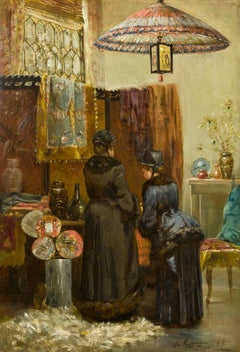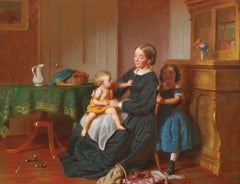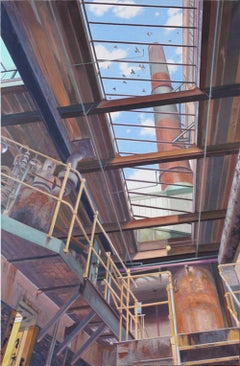Want more images or videos?
Request additional images or videos from the seller
1 of 4
Richard MauryCharles Cecil1987
1987
$100,000List Price
About the Item
- Creator:Richard Maury (1935, American)
- Creation Year:1987
- Dimensions:Height: 55 in (139.7 cm)Width: 47.25 in (120.02 cm)
- Condition:
- Gallery Location:New York, NY
- Reference Number:Seller: M 10155D.0111stDibs: G13081323520
About the Seller
5.0
Recognized Seller
These prestigious sellers are industry leaders and represent the highest echelon for item quality and design.
Established in 1952
1stDibs seller since 2010
35 sales on 1stDibs
Typical response time: 22 hours
Associations
Art Dealers Association of America
Authenticity Guarantee
In the unlikely event there’s an issue with an item’s authenticity, contact us within 1 year for a full refund. DetailsMoney-Back Guarantee
If your item is not as described, is damaged in transit, or does not arrive, contact us within 7 days for a full refund. Details24-Hour Cancellation
You have a 24-hour grace period in which to reconsider your purchase, with no questions asked.Vetted Professional Sellers
Our world-class sellers must adhere to strict standards for service and quality, maintaining the integrity of our listings.Price-Match Guarantee
If you find that a seller listed the same item for a lower price elsewhere, we’ll match it.Trusted Global Delivery
Our best-in-class carrier network provides specialized shipping options worldwide, including custom delivery.You May Also Like
Lady in the window. Contemporary figurative Painting, Art deco, Polish art
Located in Warsaw, PL
Contemporary print on paper by Polish artist Danuta Dabrowska-Siemaszkiewicz. Artist is inspired by 20th century culture, art deco and pop culture. This artwork depicts portrait of A...
Category
2010s Other Art Style Figurative Paintings
Materials
Canvas, Oil
$5,577
H 23.63 in W 39.38 in D 0.79 in
9:10 AM
Located in La Baule-Escoublac, FR
In his very Californian settings, Marius Messinese creates an environment that is both synthetic and realistic, halfway between seduction and intrigue. At the crossroads of different...
Category
2010s Contemporary Figurative Paintings
Materials
Canvas, Acrylic
Littoral
Located in La Baule-Escoublac, FR
In his very Californian settings, Marius Messinese creates an environment that is both synthetic and realistic, halfway between seduction and intrigue. At the crossroads of different...
Category
2010s Contemporary Figurative Paintings
Materials
Canvas, Acrylic
Reflecting water
Located in La Baule-Escoublac, FR
In his very Californian settings, Marius Messinese creates an environment that is both synthetic and realistic, halfway between seduction and intrigue. At the crossroads of different...
Category
2010s Contemporary Figurative Paintings
Materials
Canvas, Acrylic
Garden Level 1
Located in La Baule-Escoublac, FR
In his very Californian settings, Marius Messinese creates an environment that is both synthetic and realistic, halfway between seduction and intrigue. At the crossroads of different...
Category
2010s Contemporary Figurative Paintings
Materials
Canvas, Acrylic
On fire
Located in La Baule-Escoublac, FR
In his very Californian settings, Marius Messinese creates an environment that is both synthetic and realistic, halfway between seduction and intrigue. At the crossroads of different...
Category
2010s Contemporary Figurative Paintings
Materials
Canvas, Acrylic
8:48 PM
Located in La Baule-Escoublac, FR
In his very Californian settings, Marius Messinese creates an environment that is both synthetic and realistic, halfway between seduction and intrigue. At the crossroads of different...
Category
2010s Contemporary Figurative Paintings
Materials
Canvas, Acrylic
Back to Cali
Located in La Baule-Escoublac, FR
In his very Californian settings, Marius Messinese creates an environment that is both synthetic and realistic, halfway between seduction and intrigue. At the crossroads of different...
Category
2010s Contemporary Figurative Paintings
Materials
Canvas, Acrylic
Cactus maze
Located in La Baule-Escoublac, FR
In his very Californian settings, Marius Messinese creates an environment that is both synthetic and realistic, halfway between seduction and intrigue. At the crossroads of different...
Category
2010s Contemporary Figurative Paintings
Materials
Canvas, Acrylic
Sea view
Located in La Baule-Escoublac, FR
In his very Californian settings, Marius Messinese creates an environment that is both synthetic and realistic, halfway between seduction and intrigue. At the crossroads of different...
Category
2010s Contemporary Figurative Paintings
Materials
Canvas, Acrylic
More From This Seller
View AllThe Japanese Corner
By Elliott Daingerfield
Located in New York, NY
A child of the American South, Elliott Daingerfield was born in Harper’s Ferry, Virginia, and raised in Fayetteville, North Carolina, where his father, C...
Category
19th Century American Impressionist Interior Paintings
Materials
Canvas, Oil
Peek-a-Boo
By Seymour Joseph Guy
Located in New York, NY
In the latter half of the nineteenth century and into the first decade of the twentieth, New York City art aficionados could count on finding recent work of Seymour Joseph Guy hanging on the walls of the city’s major galleries. Primarily a genre artist, but also a portraitist, between 1859 and 1908 Guy showed more than seventy works at the National Academy of Design. From 1871 to 1903 he contributed over seventy times to exhibitions at the Century Club. From 1864 to 1887, he sent about forty pictures to the Brooklyn Art Association. A good number of these works were already privately owned; they served as advertisements for other pictures that were available for sale. Some pictures were shown multiple times in the same or different venues. Guy was as easy to find as his canvases were omnipresent. Though he lived at first in Brooklyn with his family and then in New Jersey, from 1863 to his death in 1910 he maintained a studio at the Artist’s Studio Building at 55 West 10th Street, a location that was, for much of that period, the center of the New York City art world.
Guy’s path to a successful career as an artist was by no means smooth or even likely. Born in Greenwich, England, he was orphaned at the age of nine. His early interest in art was discouraged by his legal guardian, who wanted a more settled trade for the young man. Only after the guardian also died was Guy free to pursue his intention of becoming an artist. The details of Guy’s early training in art are unclear. His first teacher is believed to have been Thomas Buttersworth...
Category
19th Century American Realist Figurative Paintings
Materials
Canvas, Oil
$110,000
Clearing
By John Moore
Located in New York, NY
John Moore was born in St. Louis, MO in 1941. He received a BFA from Washington University in St. Louis (1966) and an MFA from Yale University (1968). Over a career spanning forty ye...
Category
2010s Contemporary Interior Paintings
Materials
Canvas, Oil
$115,000
Distant Voices
By John Moore
Located in New York, NY
John Moore was born in St. Louis, MO in 1941. He received a BFA from Washington University in St. Louis (1966) and an MFA from Yale University (1968). Over a career spanning forty ye...
Category
2010s Contemporary Interior Paintings
Materials
Canvas, Oil
Interior of a Japanese House
By Harry Humphrey Moore
Located in New York, NY
Harry Humphrey Moore led a cosmopolitan lifestyle, dividing his time between Europe, New York City, and California. This globe-trotting painter was also active in Morocco, and most importantly, he was among the first generation of American artists to live and work in Japan, where he depicted temples, tombs, gardens, merchants, children, and Geisha girls. Praised by fellow painters such as Thomas Eakins, John Singer Sargent, and Jean-Léon Gérôme, Moore’s fame was attributed to his exotic subject matter, as well as to the “brilliant coloring, delicate brush work [sic] and the always present depth of feeling” that characterized his work (Eugene A. Hajdel, Harry H. Moore, American 19th Century: Collection of Information on Harry Humphrey Moore, 19th Century Artist, Based on His Scrap Book and Other Data [Jersey City, New Jersey: privately published, 1950], p. 8).
Born in New York City, Moore was the son of Captain George Humphrey, an affluent shipbuilder, and a descendant of the English painter, Ozias Humphrey (1742–1810). He became deaf at age three, and later went to special schools where he learned lip-reading and sign language. After developing an interest in art as a young boy, Moore studied painting with the portraitist Samuel Waugh in Philadelphia, where he met and became friendly with Eakins. He also received instruction from the painter Louis Bail in New Haven, Connecticut. In 1864, Moore attended classes at the Mark Hopkins Institute in San Francisco, and until 1907, he would visit the “City by the Bay” regularly.
In 1865, Moore went to Europe, spending time in Munich before traveling to Paris, where, in October 1866, he resumed his formal training in Gérôme’s atelier, drawing inspiration from his teacher’s emphasis on authentic detail and his taste for picturesque genre subjects. There, Moore worked alongside Eakins, who had mastered sign language in order to communicate with his friend. In March 1867, Moore enrolled at the prestigious École des Beaux-Arts, honing his drawing skills under the tutelage of Adolphe Yvon, among other leading French painters.
In December 1869, Moore traveled around Spain with Eakins and the Philadelphia engraver, William Sartain. In 1870, he went to Madrid, where he met the Spanish painters Mariano Fortuny and Martin Rico y Ortega. When Eakins and Sartain returned to Paris, Moore remained in Spain, painting depictions of Moorish life in cities such as Segovia and Granada and fraternizing with upper-crust society. In 1872, he married Isabella de Cistue, the well-connected daughter of Colonel Cistue of Saragossa, who was related to the Queen of Spain. For the next two-and-a-half years, the couple lived in Morocco, where Moore painted portraits, interiors, and streetscapes, often accompanied by an armed guard (courtesy of the Grand Sharif) when painting outdoors. (For this aspect of Moore’s oeuvre, see Gerald M. Ackerman, American Orientalists [Courbevoie, France: ACR Édition, 1994], pp. 135–39.) In 1873, he went to Rome, spending two years studying with Fortuny, whose lively technique, bright palette, and penchant for small-format genre scenes made a lasting impression on him. By this point in his career, Moore had emerged as a “rapid workman” who could “finish a picture of given size and containing a given subject quicker than most painters whose style is more simple and less exacting” (New York Times, as quoted in Hajdel, p. 23).
In 1874, Moore settled in New York City, maintaining a studio on East 14th Street, where he would remain until 1880. During these years, he participated intermittently in the annuals of the National Academy of Design in New York and the Pennsylvania Academy of the Fine Arts in Philadelphia, exhibiting Moorish subjects and views of Spain. A well-known figure in Bay Area art circles, Moore had a one-man show at the Snow & May Gallery in San Francisco in 1877, and a solo exhibition at the Bohemian Club, also in San Francisco, in 1880. Indeed, Moore fraternized with many members of the city’s cultural elite, including Katherine Birdsall Johnson (1834–1893), a philanthropist and art collector who owned The Captive (current location unknown), one of his Orientalist subjects. (Johnson’s ownership of The Captive was reported in L. K., “A Popular Paris Artist,” New York Times, July 23, 1893.) According to one contemporary account, Johnson invited Moore and his wife to accompany her on a trip to Japan in 1880 and they readily accepted. (For Johnson’s connection to Moore’s visit to Japan, see Emma Willard and Her Pupils; or, Fifty Years of Troy Female Seminary [New York: Mrs. Russell Sage, 1898]. Johnson’s bond with the Moores was obviously strong, evidenced by the fact that she left them $25,000.00 in her will, which was published in the San Francisco Call on December 10, 1893.) That Moore would be receptive to making the arduous voyage across the Pacific is understandable in view of his penchant for foreign motifs. Having opened its doors to trade with the West in 1854, and in the wake of Japan’s presence at the Philadelphia Centennial Exposition of 1876, American artists were becoming increasingly fascinated by what one commentator referred to as that “ideal dreamland of the poet” (L. K., “A Popular Paris Artist”).
Moore, who was in Japan during 1880–81, became one of the first American artists to travel to the “land of the rising sun,” preceded only by the illustrator, William Heime, who went there in 1851 in conjunction with the Japanese expedition of Commodore Matthew C. Perry; Edward Kern, a topographical artist and explorer who mapped the Japanese coast in 1855; and the Boston landscapist, Winckleworth Allan Gay, a resident of Japan from 1877 to 1880. More specifically, as William H. Gerdts has pointed out, Moore was the “first American painter to seriously address the appearance and mores of the Japanese people” (William H. Gerdts, American Artists in Japan, 1859–1925, exhib. cat. [New York: Hollis Taggart Galleries, 1996], p. 5).
During his sojourn in Nippon (which means, “The Land of the Rising Sun”), Moore spent time in locales such as Tokyo, Yokohama, Kyoto, Nikko, and Osaka, carefully observing the local citizenry, their manners and mode of dress, and the country’s distinctive architecture. Working on easily portable panels, he created about sixty scenes of daily life, among them this depiction of an interior of a dwelling. The location of the view is unknown, but the presence of a rustic rail fence demarcating a yard bordering a distant house flanked by tall trees, shrubs and some blossoming fruit trees, suggests that the work likely portrays a building in a city suburb or a small village.
In his book, Japanese Homes and Their Surroundings, Edward S. Morse (an American zoologist, orientalist, and “japanophile” who taught at Tokyo Imperial University from 1877 to 1879, and visited Japan again in 1891 and 1882) noted the “openness and accessibility of the Japanese house...
Category
Late 19th Century Interior Paintings
Materials
Oil, Wood Panel
Dye House
By John Moore
Located in New York, NY
Signed and dated (at lower right): MOORE 12
Category
2010s Contemporary Interior Paintings
Materials
Oil
Price Upon Request
Recently Viewed
View AllMore Ways To Browse
Man Ray Picasso
Mimi Gross Grooms
Musician Painting Large
Oil Painting Afternoon Tea
Oil Painting Of Nuns
Old Man A S
Old Master Mother Child
Olle Hjortzberg
Paintings Of Celebrities
Park Bench Oil Painting
Pater Paintings
People On Beach Paintings
Picot Painting
Pierrot And Harlequin
Playing Marbles
Prada Painting
Pulp Illustration
Raggedy Ann Doll



